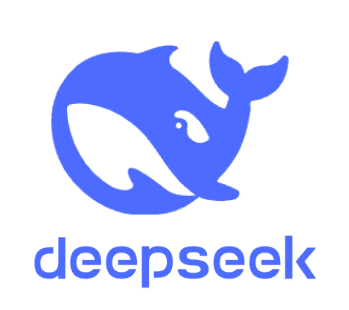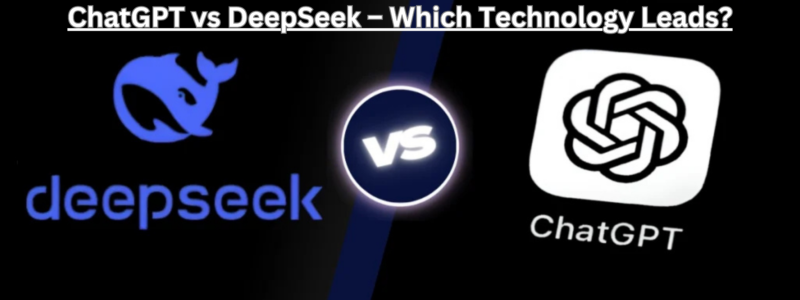As we know we lives in AI world where new tools and platforms continue to emerge, each offering unique capabilities. Two of the most prominent AI tools today are ChatGPT and DeepSeek. While both fall under the umbrella of artificial intelligence, they have distinct purposes, strengths, and applications.This article delves into how DeepSeek and ChatGPT compare, highlighting their unique strengths and differences.
Let’s have a detail discussion now.

What’s DeepSeek?
DeepSeek is a prominent Chinese artificial intelligence (AI) company specializing in the development of open-source large language models (LLMs). These advanced models are designed to process and generate human-like text by leveraging vast datasets and sophisticated machine learning techniques.
For those unfamiliar with LLMs, they are a subset of machine learning models that:
- Utilize deep learning algorithms to analyze and interpret textual data.
- Are trained on extensive datasets, often encompassing millions or billions of words, to understand language patterns, context, and semantics.
- Generate coherent and contextually relevant text, mimicking human communication.
What Makes DeepSeek Unique?
- Multilingual Training: DeepSeek is trained on both Chinese and English data, making it highly effective in multilingual and culturally specific contexts.
- Open-Source Accessibility: Unlike many competitors, DeepSeek provides open-source models, allowing developers to access, modify, and build upon its code freely.
- Cost-Free Access: Currently, DeepSeek’s AI models, including its chatbot and coder tools, are available for free, offering accessibility to a broad user base.
- Specialized Models: Models like DeepSeek-Coder are designed for specific applications, such as coding, with extensive training on diverse programming languages.
- Focus on AGI: DeepSeek is geared toward achieving Artificial General Intelligence (AGI), aiming for adaptability and versatility beyond narrow AI applications.
How to Experience DeepSeek?
- Download the App: DeepSeek’s chatbot app is available for free download on major platforms since its release on January 10, 2025.
- Explore the Models: Access and experiment with DeepSeek’s open-source models through their official platform or repositories.
- Try DeepSeek-Coder: Developers can use the specialized coding model, pre-trained on a wide array of programming languages, for enhanced productivity.
- Join the Community: Engage with the open-source community to explore innovative uses of DeepSeek’s AI technologies.
- Stay Updated: Keep an eye on DeepSeek’s official website for the latest releases and updates on its growing AI ecosystem.
AI Showdown 2025: ChatGPT vs DeepSeek – Which Technology Leads?
As artificial intelligence continues to evolve, two cutting-edge platforms have garnered significant attention: ChatGPT and DeepSeek. Both tools leverage the power of AI, but each is designed with a unique focus and set of capabilities. In this showdown, we will explore the differences between ChatGPT and DeepSeek in 2025, looking at everything from their architectural design to their performance in real-world applications. Let’s dive into the details and determine which technology leads the way in the rapidly growing AI landscape.

Analyzing the Architectural Frameworks of DeepSeek and ChatGPT
The underlying architecture of both ChatGPT and DeepSeek shapes their respective strengths and weaknesses. While both are AI-powered, their structures and core technologies are fundamentally different, resulting in different use cases and user experiences.
ChatGPT Architecture
- Base Model: ChatGPT is built on OpenAI’s GPT-4 architecture, which is a large transformer-based language model.
- Training Data: Trained on vast amounts of text data from a diverse range of sources, including books, websites, and academic papers, allowing it to generate human-like text.
- Focus: Primarily focused on natural language understanding and text generation, designed to simulate conversation, answer questions, and assist in content creation.
- Response Generation: Uses a generative approach to predict the next word or phrase based on the input it receives, making conversations fluid and contextually relevant.
- Limitations: Can sometimes struggle with maintaining long-term context in conversations and providing factually accurate answers beyond its training data.
DeepSeek Architecture
- Base Model: DeepSeek operates using advanced semantic search and knowledge graph technologies. It’s designed for deep information retrieval and analysis.
- Training Data: Unlike ChatGPT, which relies mainly on text, DeepSeek integrates structured datasets, research papers, and corporate knowledge bases to enhance its performance in niche industries like data science and business intelligence.
- Focus: DeepSeek excels at information extraction from large data sets, offering powerful data analytics, and semantic search capabilities, helping users navigate complex databases.
- Search Precision: Focuses on precise, context-aware search algorithms that can extract actionable insights from data, rather than generating conversational responses.
- Limitations: While it excels at finding specific data points, it lacks the conversational fluidity and general-purpose application that ChatGPT offers.
Performance Assessment and Benchmarking
To truly understand the strengths of both ChatGPT and DeepSeek, we need to look at performance benchmarks that test their effectiveness in real-world applications. Each tool shines in different areas, depending on the task at hand.
ChatGPT Performance Benchmarks
- Speed: ChatGPT offers real-time responses, typically taking seconds to process input and generate text. The response speed is consistent for general queries and casual conversations.
- Accuracy in Content Generation: ChatGPT has been shown to produce highly accurate content for a wide range of topics, but can occasionally make factual errors, particularly with complex, niche topics or outdated data.
- Scalability: ChatGPT performs consistently well, even with multiple users interacting simultaneously, thanks to OpenAI’s scalable infrastructure. However, with longer and more complex interactions, the quality of responses may decline.
- User Experience: Users generally find ChatGPT to be intuitive and easy to interact with. However, the system can struggle with deeply specialized tasks, where precision is required.
Evaluating DeepSeek’s Performance Metrics
- Speed: DeepSeek excels in handling complex queries and searching through vast datasets in a matter of seconds. Its advanced algorithms ensure quick data retrieval, making it ideal for professional research and data analytics tasks.
- Accuracy in Search: When it comes to retrieving data, DeepSeek outperforms standard search engines, offering highly relevant and contextualized results. However, its precision is most effective when working with structured datasets, and may not perform as well with unstructured, casual language inputs.
- Scalability: DeepSeek is optimized for large-scale data analysis. It can seamlessly process terabytes of data, making it an invaluable tool for businesses or research organizations with vast datasets to analyze.
- User Experience: The platform is designed for data professionals and may require some technical knowledge to fully leverage its features. While it offers advanced tools, the interface may be complex for casual users.
DeepSeek vs ChatGPT: Language, Tech, and Usability
When comparing DeepSeek and ChatGPT, two of the most notable AI language models, we can see distinct differences in language support, technological foundations, and overall usability. Here’s a breakdown of how these two models compare:
Language Processing
- ChatGPT:
- Known for its strong natural language understanding and generation capabilities.
- Excels at creative writing, code generation, and answering complex questions.
- Widely used for tasks like content creation, translation, and customer service.
- DeepSeek:
- Demonstrates competitive language processing abilities, rivaling ChatGPT in certain benchmarks.
- Focuses on efficiency and accuracy, particularly in reasoning tasks.
- Potentially advantageous for applications requiring precise language understanding and logical inference.
Technology & Training
- DeepSeek:
- Open-Source Advantage: DeepSeek is built on an open-source model, allowing developers to access, modify, and improve the AI freely, fostering a community-driven approach to development.
- Focus on AGI: DeepSeek is oriented toward achieving Artificial General Intelligence (AGI), which could lead to more adaptable AI systems that handle complex tasks across a wide range of domains.
- Optimized for Specific Domains: DeepSeek may offer more precision in specialized fields like finance, healthcare, or legal services due to its domain-specific training.
- ChatGPT:
- Proprietary Model: ChatGPT, developed by OpenAI, operates on proprietary technology with closed-source models, meaning users can’t modify or access the underlying code.
- Task-Specific Intelligence: ChatGPT focuses primarily on narrow AI, excelling in conversational tasks, writing assistance, and answering general queries but may need fine-tuning for specialized use cases.
- Integration Ecosystem: ChatGPT boasts a rich ecosystem with integrations like APIs, plugins, and partnerships with companies such as Microsoft, offering a broader range of applications for businesses.
Usability and User Experience
DeepSeek:
- Free and Open-Access: Currently, DeepSeek is accessible for free, providing users with easy access to powerful AI tools without a subscription or high cost.
- Tech-Savvy Audience: Due to its open-source nature, DeepSeek appeals more to developers and those who are familiar with modifying or improving AI systems.
- Focused on Efficiency: DeepSeek is built with a strong emphasis on performance, especially in specialized applications like coding or language processing for specific regions.
ChatGPT:
- User-Friendly Interface: ChatGPT has a very intuitive, easy-to-use interface that appeals to a broader, less technical audience, including casual users, professionals, and businesses.
- Widespread Accessibility: ChatGPT is available through multiple platforms, including web applications and integrations with other services, making it easy for users to access anytime, anywhere.
- Strong Brand Recognition: With its widespread adoption, ChatGPT has become a household name in the AI industry, making it a go-to choice for most users seeking conversational AI solutions.
DeepSeek vs ChatGPT: Language, Tech, and Usability
When comparing DeepSeek and ChatGPT, two of the most notable AI language models, we can see distinct differences in language support, technological foundations, and overall usability. Here’s a breakdown of how these two models compare:
Language Support
- DeepSeek:
- Multilingual Expertise: DeepSeek is specifically designed to handle both Chinese and English text, making it especially useful in regions with a focus on Chinese-speaking populations.
- Cultural Relevance: DeepSeek is trained with data that includes both Western and Chinese language structures, ensuring it adapts better to the nuances of both languages and cultures.
- Superior Chinese Handling: The model excels at processing Chinese text, catering more effectively to Mandarin speakers compared to many other global models.
- ChatGPT:
- Global Language Coverage: ChatGPT supports a wide range of languages, including English, Spanish, French, German, and many more, making it versatile for users around the world.
- Focus on English: While it supports multiple languages, the model performs optimally with English and might not always deliver the same accuracy in other languages.
- Cultural Neutrality: ChatGPT focuses more on global usage, which may not always capture regional nuances as well as DeepSeek.
Technology & Training
- DeepSeek:
- Open-Source Advantage: DeepSeek is built on an open-source model, allowing developers to access, modify, and improve the AI freely, fostering a community-driven approach to development.
- Focus on AGI: DeepSeek is oriented toward achieving Artificial General Intelligence (AGI), which could lead to more adaptable AI systems that handle complex tasks across a wide range of domains.
- Optimized for Specific Domains: DeepSeek may offer more precision in specialized fields like finance, healthcare, or legal services due to its domain-specific training.
- ChatGPT:
- Proprietary Model: ChatGPT, developed by OpenAI, operates on proprietary technology with closed-source models, meaning users can’t modify or access the underlying code.
- Task-Specific Intelligence: ChatGPT focuses primarily on narrow AI, excelling in conversational tasks, writing assistance, and answering general queries but may need fine-tuning for specialized use cases.
- Integration Ecosystem: ChatGPT boasts a rich ecosystem with integrations like APIs, plugins, and partnerships with companies such as Microsoft, offering a broader range of applications for businesses.
Usability and User Experience
- DeepSeek:
- Free and Open-Access: Currently, DeepSeek is accessible for free, providing users with easy access to powerful AI tools without a subscription or high cost.
- Tech-Savvy Audience: Due to its open-source nature, DeepSeek appeals more to developers and those who are familiar with modifying or improving AI systems.
- Focused on Efficiency: DeepSeek is built with a strong emphasis on performance, especially in specialized applications like coding or language processing for specific regions.
- ChatGPT:
- User-Friendly Interface: ChatGPT has a very intuitive, easy-to-use interface that appeals to a broader, less technical audience, including casual users, professionals, and businesses.
- Widespread Accessibility: ChatGPT is available through multiple platforms, including web applications and integrations with other services, making it easy for users to access anytime, anywhere.
- Strong Brand Recognition: With its widespread adoption, ChatGPT has become a household name in the AI industry, making it a go-to choice for most users seeking conversational AI solutions.
DeepSeek and ChatGPT bring unique strengths to the table. DeepSeek stands out for its multilingual capabilities, especially in Chinese, its open-source model, and its long-term goals in AGI development. On the other hand, ChatGPT excels in global language support, a user-friendly interface, and a robust ecosystem that makes it ideal for both casual and professional use.
Choosing between the two largely depends on the user’s needs:
- DeepSeek is ideal for those seeking multilingual AI, more specialized use cases, or those who wish to engage with an open-source community.
- ChatGPT, with its broader language reach and ease of use, remains the more popular choice for casual users and businesses worldwide.
Comparing Response Times: Who is better DeepSeek vs ChatGPT?
When it comes to response times, DeepSeek and ChatGPT have notable differences, especially when handling technical or task-specific queries. In this comparison, we’ll explore how their speed measures up in various use cases, particularly in programming, real-time processing, and task-oriented performance.
Speed Edge: DeepSeek vs ChatGPT
In terms of response times, DeepSeek has a clear advantage, especially when dealing with technical or complex queries. For instance, when asked to generate or process code in programming languages like Python or Java, DeepSeek typically delivers responses much quicker than ChatGPT.
- DeepSeek’s Speed: For content-related tasks, DeepSeek can provide results in as little as 10 seconds, depending on the complexity of the request.
- ChatGPT’s Response Time: On the other hand, ChatGPT can take around 30 seconds to process similar content generation tasks.
This makes DeepSeek a more efficient choice for users looking for rapid answers in specialized fields like coding or technical inquiries.
Real-Time Processing: DeepSeek’s Advantage
DeepSeek is built with real-time processing in mind, which is a key factor that drives its faster response rates. This architecture enables it to quickly analyze and process data, significantly reducing the time spent on specific tasks.
- Efficiency: Users have reported up to a 40% reduction in task completion time when switching from ChatGPT to DeepSeek. For example, what might take a user several minutes on ChatGPT could be completed in mere seconds on DeepSeek.
This makes DeepSeek an ideal solution for those who require instantaneous processing, such as professionals handling high-volume queries or working in fields like data science or business analytics.
Task-Specific Performance: DeepSeek’s Precision
When it comes to task-specific queries, DeepSeek continues to outperform ChatGPT in terms of response speed. Particularly for tasks like data analysis or customer query responses, DeepSeek’s specialized design allows it to process and retrieve relevant information almost instantly.
- Data Analysis and Customer Support: DeepSeek can provide near-instantaneous answers, which is crucial for tasks requiring quick decision-making.
- ChatGPT: In contrast, while ChatGPT is still quick, its response times for similar queries tend to be longer, generally requiring up to 10 seconds for task-oriented questions.
For businesses that rely on fast, accurate data retrieval or require quick responses to customer inquiries, DeepSeek proves to be the more efficient choice.DeepSeek and ChatGPT excel in their own right, DeepSeek holds a clear advantage in terms of response times, particularly for technical tasks, real-time processing, and task-specific performance. Whether you’re working with large datasets, programming queries, or managing customer service, DeepSeek offers faster, more efficient results compared to ChatGPT, making it the go-to tool for users prioritizing speed and precision.
Conclusion
DeepSeek and ChatGPT both have distinct advantages tailored to different user needs. DeepSeek excels in technical tasks, such as coding and data analysis, offering faster response times and highly precise results, especially in multilingual environments like Chinese and English. Its open-source model and focus on Artificial General Intelligence (AGI) make it ideal for developers and industries requiring advanced, real-time data processing.
On the other hand, ChatGPT remains the go-to for general-purpose AI, with its user-friendly interface, global language support, and seamless integration into business ecosystems. It’s well-suited for content generation, customer support, and creative writing, offering broad accessibility for casual users and businesses alike.
Ultimately, the choice between DeepSeek and ChatGPT depends on whether users prioritize specialized, high-speed tasks or flexibility and conversational capabilities for general applications.
